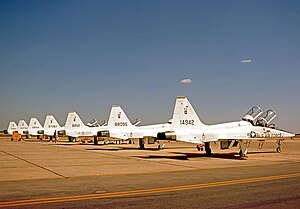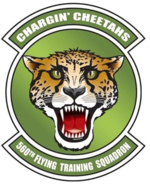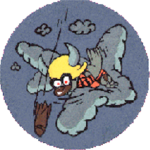The 560th Flying Training Squadron is part of the 12th Flying Training Wing of the United States Air Force based at Randolph Air Force Base, Texas. It operates the Northrop T-38 Talon.
560th Flying Training Squadron
 | |
|---|---|
 | |
| Active | 1942–1945; 1947–1949; 1962–1970; 1972–present |
| Country | |
| Branch | |
| Role | Pilot training |
| Part of | Air Education and Training Command |
| Garrison/HQ | Randolph Air Force Base |
| Nickname(s) | Chargin' Cheetahs |
| Engagements | European Theater of Operations |
| Decorations | Distinguished Unit Citation Air Force Outstanding Unit Award |
| Commanders | |
| Current commander | Lt Col Paul Fulkerson |
| Insignia | |
| 560th Flying Training Squadron emblem[b][1] |  |
| 560 Flying Training Sq emblem[c][1] |  |
| 560th Bombardment Squadron emblem[2] |  |
The squadron was first activated during World War II as the 560th Bombardment Squadron. After training with Boeing B-17 Flying Fortress aircraft in the United States, the unit moved to the European Theater of Operations, where it participated in the strategic bombing campaign against Germany. The squadron was awarded the Distinguished Unit Citation on two occasions for its performance in combat. After V-E Day, the squadron returned to the United States and was inactivated.
The squadron served in the reserve from 1947 to 1949, but apparently was only partially staffed and equipped. It was redesignated the 560th Tactical Fighter Squadron and activated in 1962. It served in the United States until 1970, training pilots for deployment to Southeast Asia, while maintaining readiness for combat operations. It deployed to Korea during the Pueblo Crisis of 1968. The squadron was again activated in its current role as a flying training unit in 1972.
Mission edit
The 560th qualifies fighter and bomber pilots as instructor pilots in the Northrop T-38C Talon. The squadron trains Air Force instructor pilots, Air Force and U.S. Navy test pilot school candidates, allied nation fighter and instructor pilots, and Air Force pilots identified for transition to fighter aircraft. The squadron currently flies a total of 8,800 hours annually in a fleet of nearly 40 aircraft and produces about 130 graduates per year.[3]
History edit
World War II edit
Initial training and deployment edit
The 560th was first activated as the 560th Bombardment Squadron at Gowen Field, Idaho, one of the four original squadrons of the 388th Bombardment Group, in December 1942.[1][4] The cadre that formed at Gowen moved to Wendover Field, Utah in February 1943, where the unit was fully staffed and squadron training with Boeing B-17 Flying Fortress heavy bombers began. Training continued until June 1943, when it deployed to England. The air echelon ferried its B-17s to England via the northern ferry route, while the ground echelon departed for Camp Kilmer, New Jersey, the port of embarkation, sailing in the RMS Queen Elizabeth on 1 July.[5]
Combat in Europe edit
The squadron assembled at RAF Knettishall, its combat station and flew its first combat mission on 17 July, when it attacked an aircraft factory in Amsterdam. The squadron primarily engaged in the strategic bombing campaign against Germany, attacking industrial sites, oil refineries and storage facilities, communications centers and naval targets on the European Continent.[4]
The squadron was awarded a Distinguished Unit Citation (DUC) for attacking an aircraft factory at Regensburg, Germany, on 17 August 1943, withstanding heavy resistance to reach the target. It was awarded a second DUC for three separate missions: an earlier attack on a tire and rubber factory in Hanover, Germany on 26 July 1943 and two missions in 1944, one against synthetic oil refineries near Brüx, Germany[e] on 12 May and at Ruhland, Germany on 21 June. This last attack was on a shuttle bombing mission from England to Germany to Poltava, USSR,[f] to Foggia, Italy, and back to England.[4][6] Other strategic targets included aircraft factories at Brunswick, Kassel, and Reims; airfields at Paris, Berlin and in Bordeaux; naval installations at Emden, Kiel and La Pallice, chemical works in Ludwigshafen; ball bearing factories at Schweinfurt and rail marshalling yards in Bielefeld, Brussels, and Osnabruck.[4]
The squadron was occasionally diverted from the strategic campaign to perform air support and interdiction missions. It attacked military installations in France in early 1944 to help prepare the way for Operation Overlord, the invasion of Normandy, and on D Day hit coastal defenses, artillery batteries and transportation targets. It attacked troop concentrations and supply depots. In July 1944, it supported Operation Cobra at Saint Lo and the following month attacked targets in Caen. It struck military installations and airfields near Arnhem during Operation Market Garden, the unsuccessful attempt to secure a bridgehead across the Rhine in the Netherlands. It attacked transportation targets to support the final drive through Germany in early 1945.[4]
Return and inactivation edit
The squadron flew its last combat mission in April 1945. After V-E Day, the squadron flew missions to the Netherlands to drop food in flooded areas. It then began redeploying to the United States. Its aircraft left Knettishall between 9 June and 5 July 1945. The ground echelon sailed again on the Queen Elizabeth on 5 August. The squadron inactivated at Sioux Falls Army Air Field, South Dakota on 28 August 1945.[1][4][5]
Reserve operations edit
The squadron was activated in the reserves at Orchard Place Airport, Illinois on 6 March 1947. It was assigned to the 338th Bombardment Group, which had been activated at Orchard Place in July 1947, at the end of September.[1][7] The squadron trained under the supervision of Air Defense Command (ADC)'s 141st AAF Base Unit (Reserve Training) (later the 2471st Air Force Reserve Flying Training Center), although it does not appear that it was fully staffed or equipped.[8]
In July 1948 Continental Air Command (ConAC) assumed responsibility for managing reserve and Air National Guard units from ADC.[9] The 560th was inactivated when ConAC reorganized its reserve units under the wing base organization system in June 1949. President Truman’s reduced 1949 defense budget also required reductions in the number of units in the Air Force,[10] At O'Hare, the 338th Group and its squadrons were inactivated, and most of its personnel transferred to the 437th Troop Carrier Wing.[7][11]
Fighter operations edit
The squadron was organized at McConnell Air Force Base, Kansas in October 1962 and assigned to the 388th Tactical Fighter Wing. In February 1964, the 388th was replaced at McConnell by the 23d Tactical Fighter Wing.[12] It was initially equipped with North American F-100 Super Sabres, but soon converted to the Republic F-105 Thunderchief. The squadron conducted tactical operations and training in preparation for global deployment and after 1966, conducted replacement training in the F-105.[13] In September 1968, it moved to Homestead Air Force Base, Florida, where it converted to the McDonnell F-4 Phantom II. It deployed to South Korea in response to North Korea's capture of the USS Pueblo in June 1969. After maintaining alert status in Korea and later Japan, the squadron returned to Homestead, where it was inactivated in October 1970,[6] and its personnel and equipment were transferred to the 309th Tactical Fighter Squadron.
Pilot training edit
On 1 May 1972, the 560th was reactivated as the 560th Flying Training Squadron at Randolph Air Force Base, Texas, and took over the mission of training Northrop T-38 Talon instructor pilots for Air Training Command's Undergraduate Pilot Training bases.[6]
After 1973, all repatriated Vietnam era prisoner of war (POW) pilots physically able to return to active flying duty came to the 560th for requalification training. As the final chapter in Operation Homecoming, the squadron returned more than 150 active duty pilots to flight status. Over the next two years the 560th flew more than 6000 hours and established a lasting bond that it still maintains with these former POWs.[6]
In October 1993, the 560th added the missions of Introduction to Fighter Fundamentals and Upgrade Instructor Pilot Training in the "Smurf Jet" AT-38. In May 1998, the Smurf operation had become squadron-sized and was split off to reactivate the 435th Fighter Training Squadron. The 560th still prepares rated pilots from varied backgrounds for fighter lead-in training.[6]
Lineage edit
- Constituted as the 560th Bombardment Squadron (Heavy) on 19 December 1942
- Activated on 24 December 1942
- Redesignated 560th Bombardment Squadron, Heavy on 20 August 1943
- Inactivated on 28 Aug 1945
- Redesignated 560th Bombardment Squadron, Very Heavy on 6 February 1947
- Activated in the reserve on 6 March 1947
- Inactivated on 27 June 1949
- Redesignated 560th Tactical Fighter Squadron and activated on 1 May 1962 (not organized)
- Organized on 1 October 1962
- Inactivated on 31 October 1970
- Redesignated 560th Flying Training Squadron on 22 March 1972
- Activated on 1 May 1972[1]
Assignments edit
|
|
Stations edit
|
|
Aircraft operated edit
- Boeing B-17 Flying Fortress (1943–1945)
- North American F-100 Super Sabre (1962–1964)
- Republic F-105 Thunderchief (1963–1968)
- McDonnell F-4 Phantom II (1969–1970)
- Northrop T-38 Talon (1972–present)[1]
Awards and campaigns edit
| Award streamer | Award | Dates | Notes |
|---|---|---|---|
| Distinguished Unit Citation | 17 August 1943 | Germany, 560th Bombardment Squadron[1] | |
| Distinguished Unit Citation | 26 July 1943, 12 May 1944, 21 June 1944 | Hannover, Brux, England to Soviet Union, 560th Bombardment Squadron[1] | |
| Air Force Outstanding Unit Award | 25 Sep 1968-30 Jun 1970 | 560th Tactical Fighter Squadron[1] | |
| Air Force Outstanding Unit Award | 1 May 1972-28 February 1973 | 560th Flying Training Squadron[1] | |
| Air Force Outstanding Unit Award | 1 January 1986-31 December 1987 | 560th Flying Training Squadron[1] | |
| Air Force Outstanding Unit Award | 1 January 1988-31 December 1988 | 560th Flying Training Squadron[1] | |
| Air Force Outstanding Unit Award | 1 January 1990-31 December 1991 | 560th Flying Training Squadron[1] | |
| Air Force Outstanding Unit Award | 1 January 1992-30 June 1993 | 560th Flying Training Squadron[1] | |
| Air Force Outstanding Unit Award | 1 July 1993-30 June 1994 | 560th Flying Training Squadron[1] | |
| Air Force Outstanding Unit Award | 1 July 1995-30 June 1996 | 560th Flying Training Squadron[1] | |
| Air Force Outstanding Unit Award | 1 July 1996-30 June 1998 | 560th Flying Training Squadron[1] | |
| Air Force Outstanding Unit Award | 1 July 1998-30 June 2000 | 560th Flying Training Squadron[1] | |
| Air Force Outstanding Unit Award | 1 July 2002-30 June 2004 | 560th Flying Training Squadron[1] |
| Campaign Streamer | Campaign | Dates | Notes |
|---|---|---|---|
| Air Offensive, Europe | July 1943–5 June 1944 | 560th Bombardment Squadron[1] | |
| Air Combat, EAME Theater | July 1943–11 May 1945 | 560th Bombardment Squadron[1] | |
| Normandy | 6 June 1944 – 24 July 1944 | 560th Bombardment Squadron[1] | |
| Northern France | 25 July 1944 – 14 September 1944 | 560th Bombardment Squadron[1] | |
| Rhineland | 15 September 1944 – 21 March 1945 | 560th Bombardment Squadron[1] | |
| Ardennes-Alsace | 16 December 1944 – 25 January 1945 | 560th Bombardment Squadron[1] | |
| Central Europe | 22 March 1944 – 21 May 1945 | 560th Bombardment Squadron[1] |
See also edit
References edit
Notes edit
- Explanatory notes
- ^ In foreground is Northrop T38A-70-NO Talon, serial 67-14942. Baugher, Joe (20 April 2023). "1967 USAF Serial Numbers". Joe Baugher. Retrieved 25 April 2023.
- ^ Modified 13 April 1995.
- ^ Approved 10 April 1978.
- ^ Aircraft is Boeing B-17F-120-BO Flying Fortress, serial 42-30793, Tom Paine. It flew its last combat mission on 29 December 1944. Baugher, Joe (10 April 2023). "1942 USAF Serial Numbers". Joe Baugher. Retrieved 26 April 2023.
- ^ Now Most, Czech Republic.
- ^ Now in Ukraine.
- ^ This should probably be c. 6 July 1943. Freeman gives 7 July as the date the ground echelon arrived in the United Kingdom. Freeman, p. 255. Maurer only says the squadron arrived in June, without a specific day. Maurer, Combat Squadrons, p. 660.
- Citations
- ^ a b c d e f g h i j k l m n o p q r s t u v w x y z aa ab Robertson, Patsy (6 September 2012). "Factsheet 560 Flying Training Squadron (AETC)". Air Force Historical Research Agency. Retrieved 20 September 2018.
- ^ Watkins, pp. 76-77
- ^ "Mission Partners: 12th Operations Group". Joint Base San Antonio Public Affairs. Retrieved 30 March 2020. This article incorporates text from this source, which is in the public domain.
- ^ a b c d e f Maurer, Combat Units, pp. 275-276
- ^ a b Freeman, p. 255
- ^ a b c d e "560th Flying Training Squadron History". 502d Air Base Wing Public Affairs. 12 December 2006. Archived from the original on 20 July 2011. Retrieved 17 September 2018.
- ^ a b Maurer, Combat Units, pp. 217–218
- ^ See Robertson. (No known aircraft listed for squadron during this period).
- ^ "Abstract, Mission Project Closeup, Continental Air Command". Air Force History Index. 27 December 1961. Retrieved 24 March 2014.
- ^ Knaack, p. 25
- ^ Ravenstein, pp. 233-234
- ^ Ravenstein, pp. 44, 210
- ^ Ravenstein, p. 44
- ^ Station number in Anderson.
- ^ Station information in Robertson, except as noted.
Bibliography edit
This article incorporates public domain material from the Air Force Historical Research Agency
- Anderson, Capt. Barry (1985). Army Air Forces Stations: A Guide to the Stations Where U.S. Army Air Forces Personnel Served in the United Kingdom During World War II (PDF). Maxwell AFB, AL yes: Research Division, USAF Historical Research Center. Archived from the original (PDF) on 23 January 2016. Retrieved 28 June 2017.
- Freeman, Roger A. (1970). The Mighty Eighth: Units, Men and Machines (A History of the US 8th Army Air Force). London, England, UK: Macdonald and Company. ISBN 978-0-87938-638-2.
- Knaack, Marcelle Size (1978). Encyclopedia of US Air Force Aircraft and Missile Systems (PDF). Vol. 2, Post-World War II Bombers 1945-1973. Washington, DC: Office of Air Force History. ISBN 0-912799-59-5. Retrieved 17 December 2016.
- Maurer, Maurer, ed. (1983) [1961]. Air Force Combat Units of World War II (PDF) (reprint ed.). Washington, DC: Office of Air Force History. ISBN 0-912799-02-1. LCCN 61060979.
- Maurer, Maurer, ed. (1982) [1969]. Combat Squadrons of the Air Force, World War II (PDF) (reprint ed.). Washington, DC: Office of Air Force History. ISBN 0-405-12194-6. LCCN 70605402. OCLC 72556.
- Ravenstein, Charles A. (1984). Air Force Combat Wings, Lineage & Honors Histories 1947-1977. Washington, DC: Office of Air Force History. ISBN 0-912799-12-9. Retrieved 17 December 2016.
- Watkins, Robert (2008). Battle Colors: Insignia and Markings of the Eighth Air Force In World War II. Vol. I (VIII) Bomber Command. Atglen, PA: Shiffer Publishing Ltd. ISBN 978-0-7643-1987-7.